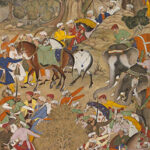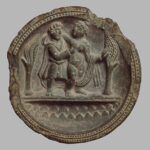The Aryans Migrate to the Indian Subcontinent
1600–1300 BCE
Indo-Aryan groups, who formed the Bactria-Margiana culture from 2000–1600 BCE, begin to migrate towards the Indian subcontinent over the next few centuries. This and other related migrations to present-day Iran from Central Asia have been confirmed by linguistic, genetic and archaeological evidence. A theory that the Indus Valley Civilisation was extinguished by an Aryan invasion (rather than the periodic migration of nomadic groups) was briefly accepted by colonial-era scholars in the early-twentieth century, but it is now believed that the descendants of these groups likely merged with the local populations and succeeded them, following the collapse of the Indus Valley Civilisation.
Bibliography
Anthony, David W. The Horse, the Wheel and Language: How Bronze-Age Riders from the Eurasian Steppes Shaped the Modern World, Princeton, NJ: Princeton University Press, 2007.
Witzel, Michael. “Indocentrism: Autochthonous Visions of Ancient India.” In The Indo-Aryan Controversy Evidence and Inference in Indian History, edited by Edwin F. Bryant and Laurie L. Patton, 341. London: Routledge, 2005.
Anthony, David W. The Horse, the Wheel and Language: How Bronze-Age Riders from the Eurasian Steppes Shaped the Modern World , Princeton University Press, 2007.
Witzel, Michael. “Indocentrism: Autochthonous Visions of Ancient India.” In The Indo-Aryan Controversy Evidence and Inference in Indian History , edited by Edwin F. Bryant, Laurie L. Patton (London and New York: Routledge, 2005), 341.
Feedback 
This entry appears in
Art in South Asia
Visit Timeline
Associated Timeline Events
First Published: March 11, 2024
Last Updated: August 17, 2024







